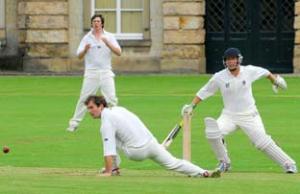
 |
| Index | ||||||
|
Overthrow, Buzzers  We have all seen it happen; most who have played the game will admit to having been guilty at one stage. The ball is hit into the outfield, the batsmen run, a vision of glory is in the fielder's mind as he launches a throw at the stumps. He misses and the batsmen take another run or, worse, the ball runs to the boundary The captain is unhappy, the bowler furious and the opposition's supporters cheer the fielder to the echo. Commentators, who never made a mistake themselves of course, will usually describe it as 'poor cricket'. And so it probably is - though nine times out of ten the real fault lies not with the unfortunate fielder who threw the ball, which may have only missed the stumps by a whisker, but with his colleagues who were not backing up properly to stop the errant ball and prevent the further run or runs from being taken The essential point is that the fielder had some sort of control over the ball, yet his throw went wrong and allowed additional runs to be scored. These additional runs are called overthrows. The name seems obvious; after all, the throw has gone beyond where the fielder intended, but names can be misleading Any throw that goes wrong and provides an opportunity for runs to be scored is an overthrow. For example, the ball might slip from a fielder's hand as he tries to throw it towards the wicket and go in some completely different direction. If he is close to the rope it might even go to the boundary behind him. This is still an overthrow because the fielder had control of the ball. On the other hand, a fielder might try to stop a ball from reaching the boundary only to fail as it bounces from his hand or off some part of his person. This is not an overthrow since he never had control of the ball Just because they are called overthrows does not mean they are scored differently. If the ball is hit by the bat, the striker is credited with the runs, otherwise they are Leg byes, Byes, No ball extras or Wides according to whether the delivery was fair or what it did or did not hit Why does all of this matter? Runs are runs, or does the fact that an overthrow occurred somewhere in the action alter things? In some ways it does. If an overthrow goes to the boundary, the runs scored are not only the allowance for the boundary, but will include any runs that have also been run by the batsmen up until the time of the throw that caused the boundary, not by the time the ball crossed it. The run in progress at the time of the throw also counts if the batsmen have crossed. So, for example if the batsmen are running and have crossed on their second run when a throw is made that subsequently reaches the boundary, they will score a total of 6 runs, 4 for the boundary, 1 that they have completed and 1 on which they have crossed. This would still be 6 runs even if they had run 3 or 4 by the time the ball crossed the boundary A very controversial overthrow incident occurred during the 2019 World Cup Final, unfortunately, the umpires awarded 6 runs instead of 5 runs to England | ||||||